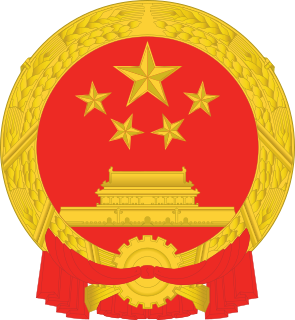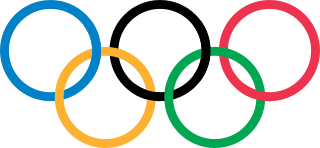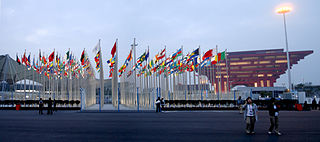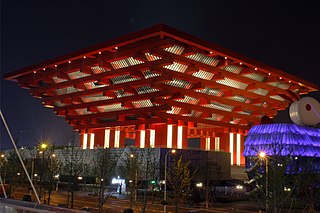Related Research Articles

Chinese culture is one of the world's oldest cultures, originating thousands of years ago. The culture prevails across a large geographical region in East Asia and is extremely diverse and varying, with customs and traditions varying greatly between provinces, cities, and even towns as well. The terms 'China' and the geographical landmass of 'China' has shifted across the centuries, with the last name being the Great Qing before the name 'China' became commonplace in modernity.

The National Emblem of the People's Republic of China contains in a red circle a representation of Tiananmen Gate, the entrance gate to the Forbidden City, where Mao Zedong declared the foundation of the People's Republic of China (PRC) in 1949. Above this representation are the five stars found on the national flag. The largest star represents the Chinese Communist Party (CCP), while the four smaller stars represent the four social classes as defined in Maoism. The emblem is described as being "composed of patterns of the national flag":
...The red color of the flag symbolizes revolution and the yellow color of the stars the golden brilliant rays radiating from the vast red land. The design of four smaller stars surrounding a bigger one signifies the unity of the Chinese people under the leadership of the Communist Party of China (CPC)
—China Yearbook 2004

Expo 2010, officially the Expo 2010 Shanghai China, was held on both banks of the Huangpu River in Shanghai, China, from 1 May to 31 October 2010. It was a major World Expo registered by the Bureau International des Expositions (BIE), in the tradition of international fairs and expositions, the first since 2005. The theme of the exposition was "Better City – Better Life" and signifies Shanghai's new status in the 21st century as the "next great world city". The Expo emblem features the Chinese character 世 modified to represent three people together with the 2010 date. It had the largest number of countries participating and was the most expensive Expo in the history of the world's fairs. The Shanghai World Expo was also the largest World's Fair site ever at 5.28 square km.

Dancing Beijing is the name of the official emblem of the 2008 Summer Olympics, which took place in Beijing in the People's Republic of China. It was unveiled on 3 August 2003 in a ceremony attended by 2,008 people at Beijing's Temple of Heaven.

Songjiang is a suburban district of Shanghai. It has a land area of 605.64 km2 (233.84 sq mi) and a population of 1,582,398 (2010). Owing to a long history, Songjiang is known as the cultural root of Shanghai.

Chinese calligraphy is the writing of Chinese characters as an art form, combining purely visual art and interpretation of the literary meaning. This type of expression has been widely practiced in China and has been generally held in high esteem across East Asia. Calligraphy is considered one of the four most-sought skills and hobbies of ancient Chinese literati, along with playing stringed musical instruments, the board game "Go", and painting. There are some general standardizations of the various styles of calligraphy in this tradition. Chinese calligraphy and ink and wash painting are closely related: they are accomplished using similar tools and techniques, and have a long history of shared artistry. Distinguishing features of Chinese painting and calligraphy include an emphasis on motion charged with dynamic life. According to Stanley-Baker, "Calligraphy is sheer life experienced through energy in motion that is registered as traces on silk or paper, with time and rhythm in shifting space its main ingredients." Calligraphy has also led to the development of many forms of art in China, including seal carving, ornate paperweights, and inkstones.

The Regional Emblem of the Hong Kong Special Administrative Region of the People's Republic of China came into use on 1 July 1997, after the transfer of the sovereignty of Hong Kong from the United Kingdom to the People's Republic of China.

The clerical script, sometimes also chancery script, is a style of Chinese writing which evolved from the late Warring States period to the Qin dynasty, matured and became dominant in the Han dynasty, and remained in largely active use through the Wei-Jin periods. In its development, it departed significantly from the earlier scripts in terms of graphic structures, and was characterized by its rectilinearity, a trait shared with the later regular script.

Each Olympic Games has its own Olympic emblem, which is a design integrating the Olympic rings with one or more distinctive elements. They are created and proposed by the Organising Committee of the Olympic Games (OCOG) or the National Olympic Committee (NOC) of the host country. It is the responsibility of the International Olympic Committee (IOC) to approve Olympic emblems for the Olympic games. The Olympic emblems are used in promotional materials, by sponsors of the Olympics, and on the uniforms of every Olympic competitor. All emblems are the property of the IOC.

Yu Youren ; was an Chinese educator, scholar, calligrapher, and politician.

The Paralympic symbols are the icons, flags, and symbols used by the International Paralympic Committee to promote the Paralympic Games.
2008 Summer Olympics marketing has been a long running campaign that began since Beijing won its bid to host the games in 2001.
The History of Shanghai expo began when numerous scholars and government officials envisioned China would one day join the world community in hosting an international global expos. Different governments have gained international experience in participating in fairs outside China. It wasn't until the later 20th century when the participation and hosting became more regular.

This article contains the details of the pavilions in Expo 2010. The 2010 World Expo Shanghai is the largest Expo site ever, covering more than 5.2 square kilometers and containing more than 70 exposition pavilions. More than 190 countries and 50 international organizations registered to participate in the 2010 Shanghai Expo. After the six-month run, the Expo had attracted well over 70 million visitors. The Expo 2010 is also the most expensive fair in the history of World's Fair, with more than 45 billion US dollars invested from the Chinese Government.

The 2010 Shanghai Expo opening ceremony (中国2010年上海世界博览会开幕式) occurred on April 30, 2010 at the Shanghai World Expo Cultural Center in Shanghai, People's Republic of China, a day before the opening of the Expo 2010.The opening ceremony was planned and designed by ECA2's founder, Yves Pepin.

Singapore's participation in the World Expo 2010 was its largest to date at the World Expo, signifying its strong and close bilateral ties with China. The Singapore pavilion showcased Singapore's achievements in urban planning, water technology and environmental services while promoting closer people-to-people relations between China and Singapore. The pavilion also highlighted Singapore's ability to offer a high-quality and integrated environment to live, work and play within a compact area through sustainable planning and development.
The Shanghai Biennale is one of the highest-profile contemporary art events in Shanghai and the most established art biennale in China. It was initially held in the Shanghai Art Museum. From 2012 on, it has been hosted in Power Station of Art, the first state-run museum dedicated to contemporary art in mainland China. Shanghai Biennale provides artists, curators, writers and art supporters from around the world with a space to meet and exchange ideas about their experiences, works and inspirations to create international dialogues. It highlights the achievements of Asian artistic creativity and production and challenges the conventional division of the world between East and West. Aside from its main museum show, it also includes talks, lectures and installations in various venues throughout the city.

The China pavilion at Expo 2010 in Pudong, Shanghai, colloquially known as the Oriental Crown, was the largest national pavilion at the Shanghai Expo and the largest display in the history of the World Expo. It was also the most expensive pavilion at the Shanghai Expo, having cost an estimated US$220 million. The pavilion showcased China's civilization and modern achievements by combining traditional and contemporary elements in its architecture, landscaping and exhibits. After the end of the Expo 2010, the building was converted to a museum. On October 1, 2012, it was reopened as the China Art Museum, the largest art museum in Asia.

The Shanghai Expo Mart, formerly the Africa Joint Pavilion, is an exhibition hall near the Huangpu River in Shanghai, China. The hall was originally constructed for Expo 2010 and consists of 21,000 square metres (230,000 sq ft) of indoor area and 3,600 square metres (39,000 sq ft) of outdoor space. The hall underwent renovation after the expo, with renovations finishing in November 2011.

The Twelve Symbols national emblem was the state emblem of the Empire of China and the Republic of China from 1913 to 1928. It was based on the ancient Chinese symbols of the Twelve Ornaments.